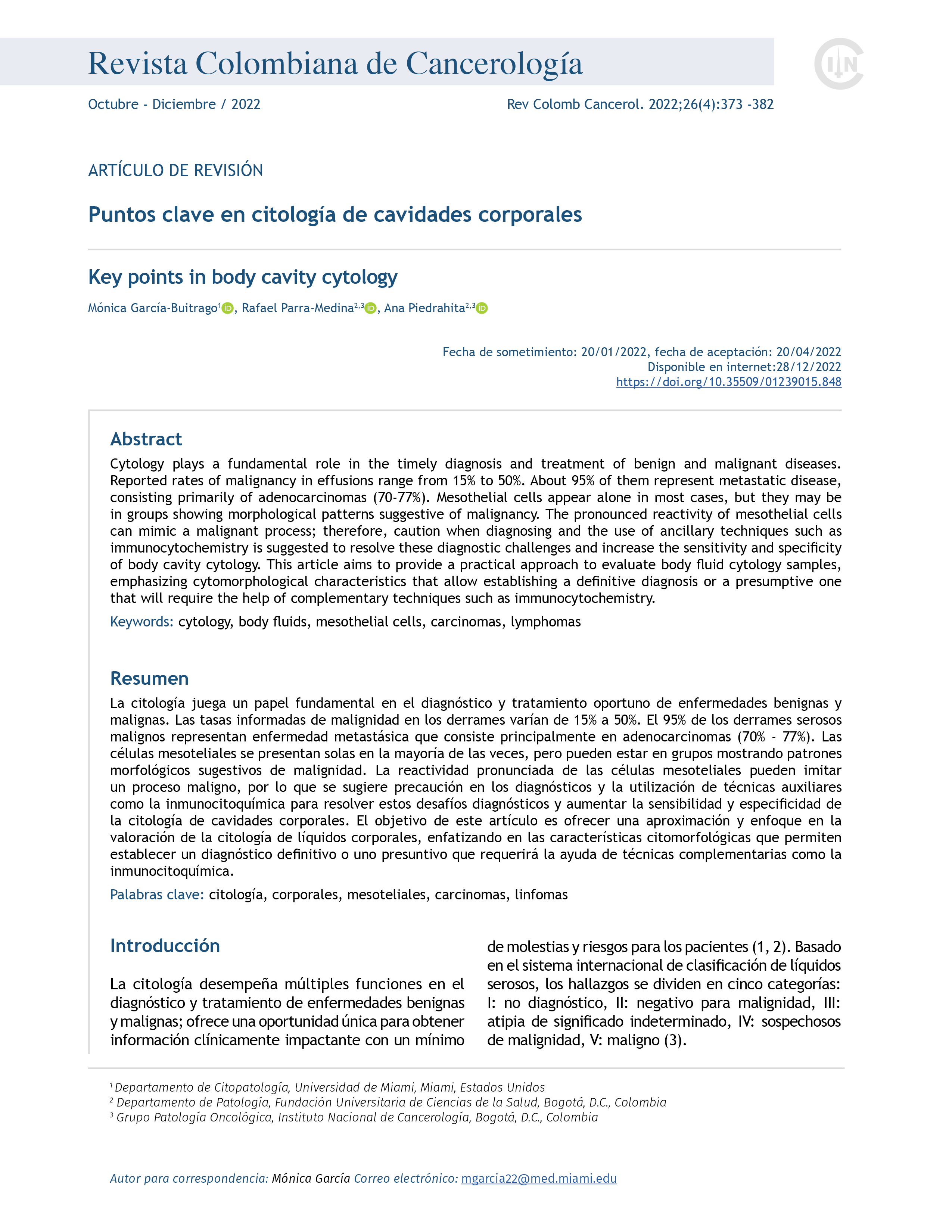Key points in body cavity cytology
DOI:
https://doi.org/10.35509/01239015.848Keywords:
cytology, body fluids, mesothelial cells, carcinomas, lymphomasAbstract
Cytology plays a fundamental role in the timely diagnosis and treatment of benign and malignant diseases. Reported rates of malignancy in effusions range from 15% to 50%. About 95% of them represent metastatic disease, consisting primarily of adenocarcinomas (70-77%). Mesothelial cells appear alone in most cases, but they may be in groups showing morphological patterns suggestive of malignancy. The pronounced reactivity of mesothelial cells can mimic a malignant process; therefore, caution when diagnosing and the use of ancillary techniques such as immunocytochemistry is suggested to resolve these diagnostic challenges and increase the sensitivity and specificity of body cavity cytology. This article aims to provide a practical approach to evaluate body fluid cytology samples, emphasizing cytomorphological characteristics that allow establishing a definitive diagnosis or a presumptive one that will require the help of complementary techniques such as immunocytochemistry.
Author Biographies
Mónica García-Buitrago , Departamento de Citopatología, Universidad de Miami, Miami, Estados Unidos.
1. Departamento de Citopatología, Universidad de Miami, Miami, Estados Unidos.
Rafael Parra-Medina, Departamento de Patología, Fundación Universitaria de Ciencias de la Salud, Bogotá, D.C., Colombia.
2. Departamento de Patología, Fundación Universitaria de Ciencias de la Salud, Bogotá, D.C., Colombia.
3. Grupo Patología Oncológica, Instituto Nacional de Cancerología, Bogotá, D.C., Colombia.
Ana Piedrahita, Departamento de Patología, Fundación Universitaria de Ciencias de la Salud, Bogotá, D.C., Colombia.
2. Departamento de Patología, Fundación Universitaria de Ciencias de la Salud, Bogotá, D.C., Colombia.
3. Grupo Patología Oncológica, Instituto Nacional de Cancerología, Bogotá, D.C., Colombia.
References
Lepus CM, Vivero M. Updates in Effusion Cytology. Surg Pathol Clin. 2018;11(3):523–44. https://doi.org/10.1016/j.path.2018.05.003
Farahani SJ, Baloch Z. Are we ready to develop a tiered scheme for the effusion cytology? A comprehensive review and analysis of the literature. Diagn Cytopathol. 2019;47(11):1145–59. https://doi.org/10.1002/dc.24278
Pinto D, Chandra A, Crothers BA, Kurtycz DFI, Schmitt F. The international system for reporting serous fluid cytopathology-diagnostic categories and clinical management. J Am Soc Cytopathol. 2020;9(6):469–77. https://doi.org/10.1016/j.jasc.2020.05.015
Tabatabai ZL, Nayar R, Souers RJ, Crothers BA, Davey DD. Performance characteristics of body fluid cytology analysis of 344 380 responses from the College of American Pathologists Interlaboratory Comparison Program in nongynecologic cytopathology. Arch Pathol Lab Med. 2018;142(1):53–8. https://doi.org/10.5858/arpa.2016-0509-CP
Cibas E, Ducatman BS. Cytology: Diagnostic principles and clinical correlates. Third edition. Philadelphia: Saunders Elsevier (2009). Available from: https://tinyurl.com/r3rwjyc4
Erozan Y. The art & science of cytopathology. Richard M. DeMay, M.D. Acta Cytologica 1996;40:606-606. https://doi.org/10.1159/000333925
Rodríguez Panadero F. Diagnóstico y tratamiento del mesotelioma pleural maligno. Arch Bronconeumol. 2015;51(4):177–84. https://doi.org/10.1016/j.arbres.2014.06.005
Pereira TC, Saad RS, Liu Y, Silverman JF. The diagnosis of malignancy in effusion cytology: A pattern recognition approach. Adv Anat Pathol. 2006;13(4):174–84. https://doi.org/10.1097/00125480-200607000-00004
Selvaggi SM. Diagnostic pitfalls of peritoneal washing cytology and the role of cell blocks in their diagnosis. Diagn Cytopathol. 2003;28(6):335–41. https://doi.org/10.1002/dc.10290
Ganjei-Azar P, Krishan A, Jorda M. Effusion cytology a practical guide to cancer diagnosis 2011. Medical Journal Armed Forces India. 2012;68(4):375. https://doi.org/10.1016/j.mjafi.2012.07.005
Porcel JM. Malignant pleural effusions because of lung cancer. Curr Opin Pulm Med. 2016;22(4):356–61. https://doi.org/10.1097/MCP.0000000000000264
Gosney JR, Boothman A-M, Ratcliffe M, Kerr KM. Cytology for PD-L1 testing: A systematic review. Lung Cancer. 2020;141:101–6. https://doi.org/10.1016/j.lungcan.2020.01.010
Hjerpe A, Abd-Own S, Dobra K. Cytopathologic diagnosis of epithelioid and mixed-type malignant mesothelioma: Ten years of clinical experience in relation to international guidelines. Arch Pathol Lab Med. 2018;142(8):893–901. https://doi.org/10.5858/arpa.2018-0020-RA
Chahin M, Seegobin K, Maharaj S, Ramsubeik K. Metastatic ductal adenocarcinoma of the breast presenting with pericardial effusion-challenges in the diagnosis of breast cancer. Clin Case Reports. 2019;7(12):2384–7. https://doi.org/10.1002/ccr3.2497
Centeno BA, Kuebler D, Warshaw AL, Lewandrowski KB. Peritoneal fluid cytology in advanced mucinous cystadenocarcinoma of the pancreas. Acta Cytol. 1996;40(2):191–5. https://doi.org/10.1159/000333736
Leichsenring J, Volckmar A-L, Kirchner M, Kazdal D, Kriegsmann M, Stögbauer F, et al. Targeted deep sequencing of effusion cytology samples is feasible, informs spatiotemporal tumor evolution, and has clinical and diagnostic utility. Genes, Chromosom Cancer. 2018;57(2):70–9. https://doi.org/10.1002/gcc.22509
Moriarty AT, Schwartz MR, Ducatman BS, Booth CN, Haja J, Chakraborty S, et al. A liquid concept - Do classic preparations of body cavity fluid perform differently than thinprep cases? Observations from the College of American Pathologists Interlaboratory Comparison Program in Nongynecologic Cytology. Arch Pathol Lab Med. 2008;132(11):1716–8. https://doi.org/10.5858/132.11.1716
McKnight R, Cohen C, Siddiqui MT. Utility of paired box gene 8 (PAX8) expression in fluid and fine-needle aspiration cytology. Cancer Cytopathol. 2010;118(5):298–302. https://doi.org/10.1002/cncy.20089
Lyons-Boudreaux V, Mody D, Zhai J, Coffey D. Cytologic malignancy versus benignancy: How useful are the “newer” markers in body fluid cytology? Arch Pathol Lab Med. 2008;13(1):32–8. https://doi.org/10.5858/2008-132-23-CMVBHU
Hyun TS, Barnes M, Tabatabai ZL. The diagnostic utility of D2-40, calretinin, CK5/6, desmin and MOC-31 in the differentiation of mesothelioma from adenocarcinoma in pleural effusion cytology. Acta Cytol. 2012;56(5):527–32. https://doi.org/10.1159/000339586
Pan Z-G, Zhang Q-Y, Lu Z-B (Jim), Quinto T, Rozenvald IB, Liu L-T, et al. Extracavitary KSHV associated Large B-Cell Lymphoma. Am J Surg Pathol. 2012;36(8):1129–40. https://doi.org/10.1097/PAS.0b013e31825b38ec
Chhabra A, Mukherjee V, Chowdhary M, Danckers M, Fridman D. Black pleural effusion: A unique presentation of metastatic melanoma. Case Rep Oncol. 2015;8(2):222–5. https://doi.org/10.1159/000430907
Beaty MW, Fetsch P, Wilder AM, Marincola F, Abati A. Effusion cytology of malignant melanoma. A morphologic and immunocytochemical analysis including application of the MART-1 antibody. Cancer. 1997;81(1):57–63. https://doi.org/10.1002/(sici)1097-0142(19970225)81:1%3C57::aid-cncr12%3E3.0.co;2-b
Mondal SK, Mondal PK, Dutta SK. Cytodiagnosis of epithelioid malignant melanoma (amelanotic) and diagnostic dilemmas. J Cytol. 2014;31:207-9. https://doi.org/10.4103/0970-9371.151134
How to Cite
Downloads

Downloads
Published
Issue
Section
License
Copyright (c) 2022 Revista Colombiana de Cancerología

This work is licensed under a Creative Commons Attribution-NonCommercial-NoDerivatives 4.0 International License.
Todos los derechos reservados.




